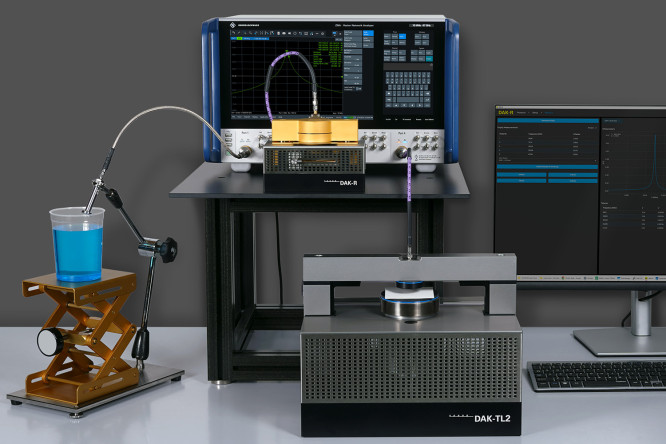
The Importance of Measuring the Dielectric Properties of Materials
Dielectric spectroscopy is used to characterize the dielectric properties of materials, i.e., how a material responds to an applied electromagnetic (EM) field as a function of the frequency of the field. With the emergence of complex new technologies in the digital age, the ability to measure dielectric data accurately, rapidly, and reliably is increasingly important for the development of, e.g., advanced materials for the energy and automotive sectors or for optimization of materials used in electronics, telecommunications, and medical devices.
In the context of SPEAG’s DAK (Dielectric Assessment Kit), dielectric spectroscopy is employed to accurately characterize the real and imaginary parts of relative permittivity (ε' and ε") of liquids, solids, and semi-solids over a wide frequency range. The advanced hardware technology and intuitive software of DAK instruments are designed for precise, accurate, and non-destructive measurements, ideal for applications in telecommunications, material science, bioelectromagnetics, and biomedical research, as well as the automotive, electronics, and food industries. SPEAG’s DAK instruments are renowned for their accuracy, speed, and ease of use, providing comprehensive dielectric characterization solutions essential for product development, quality control, and scientific research.
DAK – SPEAG's Dielectric Assessment Kit Product Line
What are DAK/S, DAK-TL2 and DAK-R?
SPEAG's Dielectric Assessment Kit (DAK) product line offers high-precision dielectric parameter measurements (permittivity, conductivity, loss tangent) over the very broad frequency range from 4 MHz to 67 GHz for various applications in the telecommunications, automative, electronic, chemical, food, and medical industries. The DAK product line consists of (i) DAK-R, the world’s first broadband resonator cavity for low-loss material characterization at 10, 17, 26, 35, and 45 GHz in a single measurement; (ii) DAK-TL2, the first ever system able to measure thin-layer materials and small volumes of liquids; (iii) DAK single probes; and (iv) the DAK System.
DAK-R's resonator cavity connects to a vector network analyzer (VNA) for two-port (S12) measurements. After measuring the empty cavity’s resonance frequency and Q-factor, a sample is placed in the gap changing the Q-factor and resonance frequency. The DAK-R software calculates permittivity and loss based on these shifts.
In DAK-TL2, DAK and DAKS, the probe is connected to a VNA for measurement of the complex reflection coefficient (S11) at the probe end. DAK software is then used to convert the measured S11 into the complex permittivity (ε) of the material under test.
|
The DAK-R is an advanced solution for non-destructive dielectric measurement of thin, low-loss substrates (0.1–3 mm). Utilizing an innovative split-cylinder resonator (SCR) design, it surpasses conventional SCRs by suppressing unwanted resonances and enabling accurate broadband measurements at 10, 17, 26, 35, and 45 GHz – all in a single instrument. Compliant with IPC TM-650 2.5.5.13, it employs TE01n resonance modes to determine a material’s relative permittivity and loss tangent. The DAK-R, paired with the DAK-TL2, sets a new benchmark for precise, broadband dielectric characterization. |
|
|
DAK-TL2* is the latest generation of SPEAG's innovation for measuring the dielectric properties of materials in thin layers with high precision over a broad frequency range. The Dielectric Assessment Kit for Thin Layers Version 2 (DAK-TL2) features nondestructive measurement of solid and semi-solid materials of limited thickness (100 µm – 10 mm) and small quantities (10 – 50 mL) of liquids across the 4 MHz – 67 GHz frequency range. DAK-TL2, especially well suited for characterizing thin solids, small liquid volumes, and precious biological samples, is based on a novel algorithm formulated by the IT'IS Foundation for dielectric characterization of samples of limited size or volume. Three probe configurations are available for DAK-TL2:
The choice of probe is dependent on the frequency range of interest and the size and type of material to be tested. The system can be easily extended by purchasing additional probes. *DAK-TL2 replaces DAK-TL, which was discontinued in August 2020 – contact us at info@speag.swiss if you are interested in upgrading your DAK-TL unit to DAK-TL2! |
|
|
The DAK instrument consists of a single open-ended coaxial probe supported by a mounting arm and connected via a high-quality cable to any compatible VNA. Three individual probes are available that – enabled by advanced algorithms – extend the frequency range of DAK probes down to 4 MHz (DAK-12) and up to 67 GHz (DAK-1.2E) without damaging the material under test and with no compromise on uncertainty. SPEAG's commitment to precision manufacturing produces probes with minimal unwanted reflections, and optimized probe materials and shapes ensure excellent contact with the material under test. The probes are easy to clean for minimal cross-contamination between measurements. A novel shorting block for excellent system calibration, which is key for highly accurate and precise measurements, is included in each DAK purchase. Three DAK single probe solutions are available:
The choice of probe is dependent on the frequency range of interest, and the system can be easily extended by purchasing additional probes |
|
|
The DAK System is based on the same probe technology as the single probe DAK instrument, but with the vector reflectometer integrated via a rigid connection to eliminate phase distortions due to cable movements Two versions of DAKS are available: DAKS-12: 4 MHz – 3 GHz, with integrated vector reflectometer model R60 from Copper Mountain Technologies DAKS-3.5: 200 MHz – 14 GHz with integrated vector reflectometer model R140 from Copper Mountain Technologies |
|
|
DAK-LF |
DAK-LF is a low-frequency probe based on a 4-point impedance measurement approach with dielectric measurement capabilities that extend down into the kHz-range Release date: 2025Q4 |





